
American History
The Library of Congress has an outstanding collection of research materials in American history. The rarest of these books, pamphlets, broadsides, and material in other formats reside in the Rare Book and Special Collections Division. Beginning with the European exploration and discovery of the Americas through the present, the division's collection is a treasure trove for the study of American culture. Our holdings are so abundant that we can only touch on some of the highlights.
Let us begin with Christopher Columbus. Upon his return from his first voyage to the Indies in 1493, Columbus sent a letter to the Spanish court reporting his discoveries. Although the original of this letter has not survived, it was quickly translated into Latin, the international language, and the copy was sent to Rome, where it was immediately published. The pamphlet, Epistola de insulis nuper inventis [Rome: Stephan Plannck, after 29 April 1493], spread the news of Columbus's discovery throughout Europe, and this edition is found in our incunabula collection. The following year another edition appeared in Basel, featuring eight fanciful woodcut illustrations. This book, De insulis in mari Indico nuper inventis, became part of the collection of the Albany, New York, politician and businessman John Boyd Thacher, which his widow bequeathed to the Library in 1925.
![Thumbnail image of Cristoforo Colombo's "De insulis in mari Indico nuper inventis ([Basel], 1494))"](rat10001.jpg) |
Cristoforo Colombo. De insulis in
mari Indico nuper inventis ([Basel], 1494). This fanciful maplike illustration, showing the islands which Colombus named, is one of eight woodcuts accompanying the second edition of the Columbus letter published in Basel. The division also has the 1493 Latin translation of the letter, the edition that spread the news of discovery throughout Europe. (John Boyd Thacher Collection) |
Thacher's collection also contains numerous editions of Ptolemy's Geography, with its engraved map that represents the known world on the eve of Columbus's voyage. The rare manuscript "Copia de littere mandate par Anzolo Trevisan" [1501-1503] contains the second account of Columbus's voyages to the New World, abstracted by Angelo Trevisan from Peter Martyr's notes and subsequently published in Venice in 1504, well before Martyr's series of letters on exploration and discovery, the Decades, came out. Trevisan also records the only known contemporary physical description of Columbus. We find the first biographical account of Columbus in another Thacher gift--the first polyglot Psalter, printed in Genoa in 1516.
As we all know, Columbus's name did not settle on the New World. Martin Waldseemueller in his Cosmographiae introductio [St. Die: Walter Lud, 1507] makes the famous suggestion that the New World be named "America" after the explorer Amerigo Vespucci. The noted bibliographer and Columbus historian, Henry Harrisse, purchased the division's copy, one of three rare editions eventually owned by Thacher, in Rome in 1871 and believed it to be the Vatican copy. Harrisse's own collection of works about Columbus and discovery came to the Library five years after his death in 1910. This gathering of Columbiana includes over 400 works written or collected by Harrisse on the age of American discovery and exploration from Columbus to 1557. Among its rarities is C. Valerius Flaccus's Argonauticon libri octo cum eruditissimis Aegidij Maserij commentariis [Paris, 1519], which was originally owned by Columbus's son Ferdinand.
![Thumbnail image of Martin Waldseemuller's "Cosmographiae introductio" [St. Die, 1507]](rat15001.jpg) |
Martin Waldseemuller. Cosmographiae introductio [St. Die, 1507]. This collective work of the group around Waldseemuller contains the famous suggestion that the New World be named "America" for Amerigo Vespucci, as well as an account of Vespucci's voyages that credits Columbus with discovery. (John Boyd Thacher Collection) |
The Library's materials on exploration and discovery do not end with Columbus. Among the division's holdings are books on other areas of Spanish, English, and French penetration into the Americas. The various editions of Peter Martyr's Decades, beginning with the first in 1511, document discovery in the New World. The second letter of Hernando Cortés to Charles V, Praeclara Ferdinadi Corteii de Nova maris Oceani Hyspania narratio [Nuremberg: F. Peypus, 1524], contains a map of Mexico City, most likely patterned on an Aztec original. A 1980 gift from Hans and Hanni Kraus of maps, manuscripts, printed books, medals, and portraits chronicles the explorations and exploits of Sir Francis Drake. In 1586 Drake attacked the Spanish in St. Augustine, Florida. Included in the Kraus donation is a hand-colored engraving (London, 1589) of St. Augustine depicting the attack. This is the earliest engraving of any city or territory now part of the United States. Other materials relate to Drake's circumnavigation of the earth from 1577 to 1580, the defense of Spanish America, and the famed Armada and its defeat by Drake in 1588.
![Thumbnail image of "St. Augustine" [London, 1589]](rat04001.jpg) |
"St. Augustine" [London, 1589]. This hand-colored engraving shows the Spanish town of St. Augustine, Florida, under siege from the naval forces of Sir Francis Drake in 1586. It is the earliest view of any city in what is now the United States. (Hans and Hanni Kraus Sir Francis Drake Collection) |
Early books printed in Latin America are another strength in the division's collections. Among them is a copy of the 1544 Doctrina breve, written by Juan de Zumarraga, the first bishop of Mexico, at whose instigation the printing press was introduced into the New World. Earlier publications are known to have been issued from this press, but, with the exception of a few fragments of one of these earlier books, the 1544 Doctrina is the earliest complete book printed in the western hemisphere now in existence.
The researcher will find extensive resources here on British Colonial America and the American Revolution. The Library's purchase of the Peter Force library in 1867 greatly increased our holdings of early Americana. The Force library included approximately 40,000 pamphlets, many of which related to colonial America and now reside in this division. These important collections had been formed by such individuals as Ebenezer Hazard of Philadelphia (1744-1817), one of the earliest collectors of source materials on American history; William Duane (1760-1835), regarded as the most effective journalist of his time; Jacob Bailey Moore (1797-1863), another outstanding journalist and a former librarian of the New-York Historical Society; Oliver Wolcott (1760-1833), secretary of the treasury upon Hamilton's resignation and later governor of Connecticut; and finally the Massachusetts merchant and legislator Israel Thorndike (1755-1832).
The receipt of such collections as the one assembled by Peter Force greatly enriched our holdings of books printed in America before 1801. The division has 43 percent of the approximately 40,000 items known to have been printed in America before 1801. Pride of place in this gathering is held by the first extant book printed in British America, the 1640 Bay Psalm Book. Other rarities include Richard Mather's The Summe of Certain Sermons upon Genesis: 156 (Cambridge: Richard Green, 1652); the Rhode Island Almanack (Newport, R. I.: James Franklin, 1727); and A Brief Narrative of the Case and Trial of John Peter Zenger (New York, 1770). A recent acquisition is the very rare Constable's Pocket-Book of 1710. Other early American imprints are found in the Benjamin Franklin Collection, which contains several pamphlet volumes with marginalia in Franklin's hand as well as the London edition of his first extensive literary work, Dissertation on Liberty and Necessity (1725).
 |
The Whole Booke of Psalmes (Cambridge, Mass., 1640). Sometimes called the Bay Psalm Book, this is the first extant book printed in what is now the United States. Only eleven surviving copies are known to exist. |
 |
John Lawson. A new voyage to Carolina (London, 1709). An early eighteenth-century traveler's eyewitness descriptions of the flora and fauna and Indian customs of the Carolina backwoods. |
Thomas Jefferson's library quite naturally abounds with Americana. His library is so rich, diverse, and extensive that we can cite only a few examples. The eighteenth-century materials include a copy of The Federalist with his annotations; Jefferson's annotated copy of his first published work, A Summary View of the Rights of British America; Allen Ramsay's Thoughts on the Origin and Nature of Government; Occasioned by the Late Disputes Between Great Britain and Her American Colonies (1769) with a running counterargument in Benjamin Franklin's hand; and almost 500 presentation copies, most given to Jefferson from authors such as Joseph Cheetham, Pierre S. Dupont de Nemours, Joseph Priestley, and Benjamin Rush.
The American Almanac Collection is especially strong in the eighteenth century and contains all the editions of Poor Richard's Almanack issued after 1735. Of the division's approximately 30,000 broadsides, approximately 3,000 are from the eighteenth century. Most notable are six editions of the Declaration of Independence and James Madison's copy of perhaps the earliest issue of the Bill of Rights.
 |
The world first learned of the Declaration of Independence from this broadside, printed during the evening of July 4, 1776, by John Dunlap in Philadelphia. |
An extensive gathering of Documents of the First Fourteen Congresses, 1789-1817, greatly aids research into the history of the early American Republic. Presidential messages to Congress, legislative journals of both houses of Congress, and secret proceedings or executive journals of the Senate are among the documents, as are reports of congressional committees, communications to Congress by government officials, and petitions, memorials, and miscellaneous publications issued by congressional order.
The first half of the nineteenth century saw more and more explorers and settlers penetrating western America. The Library has abundant materials on this movement, holding almost 75 percent of the titles listed in the standard bibliography on the subject. Some significant items include the first edition of Willam B. Parsons's The New Gold Mines of Western Kansas (Cincinnati, 1858); Thomas Freeman's An Account of the Red River in Louisiana [Washington, 1806?]; and Daniel Blue's Thrilling Narrative of the Adventures, Sufferings and Starvation of Pike's Peak Gold Seekers on the Plains of the West in the Winter and Spring of 1859 (Chicago, 1860).
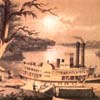 |
Henry Lewis. Das Illustrirte Mississippithal (Dusseldorf, 1857). A heavily illustrated study of the Mississippi Valley. |
An especially exciting recent addition to our western Americana holdings and indicative of their excellence is a hand-colored copy of Prince Maximilian Alexander Philipp von Wied-Neuwied's Reise in das innere Nord-America in den Jahren 1832 bis 1834, published about 1840. Prince Maximilian was an experienced world traveler and naturalist who chose the Swiss artist Karl Bodmer to accompany him on his travels through the West and to produce a complete pictorial documentary. After his journey, Maximilian published an account of his travels with a supplemental picture atlas of eighty-one polychrome prints after paintings by Bodmer. Bodmer captured a richness and depth of ethnological detail, and his depictions of the Plains Indians were the first truly accurate ones to reach the general public. The Library's copy of the atlas contains all eighty-one finely hand-colored prints.
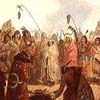 |
Prince Maximilian Alexander Philipp von Wied-Neuwield. Reise in das innere Nord-America in den Jahren 1832 bis 1834 (1840-1843). Prince Maximilian traveled deep into the American West between 1832 and 1834 with Swiss artist Karl Bodmer. The resulting published study contained eighty-one engravings after Bodmer's paintings. |
General nineteenth-century materials are so abundant that it is impossible to mention them in such a brief exposition. To give the reader an example of the excellence the Library strives for in its collections, we can cite the recent acquisition of Alexis de Tocqueville's De la démocratie en Amérique. Citing this title might not seem extraordinary, but it is the only known copy of the first edition in the original paper wrappers.
 |
Alexis de Tocqueville. De la démocratie en Amérique (1835-40). The only known set in the original wrappers. |
Materials related to slavery are numerous in the Library's collections, which include many eighteenth-century sermons and orations against the evils and injustices of the slave trade and nineteenth-century slave narratives that document the slavery experience firsthand from the point of view of the individual slave. One of the rarest and considered among the best from this genre is Henry Bibb's Narrative of the Life and Adventures of Henry Bibb, an American Slave (New York, 1849). Bibb was born into slavery in Kentucky in 1815. He recounts his sufferings, escapes, recaptures, and unsuccessful attempts to free his family. He lectured for the Liberty party in Ohio and Michigan during the 1840s and fled to Canada after the Fugitive Slave Act of 1850. Other notable slave narratives include Charles Ball's Slavery in the United States (1836) and The Life and Sufferings of Leonard Black, a Fugitive from Slavery (1847).
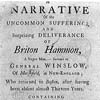 |
Narrative of the Uncommon Sufferings and Surprizing Deliverance of Briton Hammon (Boston, 1760). One of the two known copies of the first slave narrative and the first printed work of an African-American. |
 |
"Stowage of the British slave Ship Brookes under the Regulated Slave Trade, Act of 1788." The plan of the lower deck of the Brookes graphically depicts the deplorable stowage of more than 400 slaves, with a third of them stowed on closely fitting shelves. |
The subject of slavery naturally leads us to discuss our holdings on the Civil War period, and once again we find rich resources for the researcher. Most notable among many collections is the Alfred W. Stern Collection of Lincolniana. This collection consists of more than 11,000 pieces, including rare books, scholarly works, pamphlets, sheet music, newspapers, and broadsides. Alfred W. Stern resigned the vice presidency of his family's clothing business in 1926 at the age of forty-five, and turned his full energies to his already substantial Lincoln collection. The collection he formed is remarkable not only for its individual rarities but for its breadth of interest. Stern wanted to ensure that users of his materials would lack no printed document. Besides the classic nineteenth- and twentieth-century studies of Lincoln, Stern owned, for instance, John Nicolay's copy of the articles on Lincoln that he and John Hay wrote for Century Magazine. Stern also owned Andrew Carnegie's copy of Isaac Harold's Life of Abraham Lincoln in which Carnegie wrote, "Read & see what Republicanism does for a man."
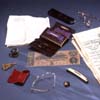 |
The contents of Abraham Lincoln's pockets on the night of his assassination are part of the Lincolniana collections at the Library. |
Stern was captivated by the fifty-two early published editions of the Emancipation Proclamation. He gathered thirty-six of these versions, including a unique copy of the first printing that was privately circulated by the president in September of 1862, four months before the proclamation was scheduled to take effect. Interestingly, it is misdated 1865. This edition was meant to be distributed to Southern slaves by Union soldiers. The mention of a few broadsides can only hint at the wealth of material in this collection: the invitation to a cotillion party in 1839 showing both Lincoln and Stephen Douglas present; the first Confederate imprint, in which the Charleston Mercury published the announcement that the South had seceded; and many Currier and Ives prints that ridiculed such matters as McClellan's political aspirations and Jefferson Davis's capture.
The Library's Civil War collections not only present the North's version of the conflict but make available one of the largest collections of Confederate imprints in existence. The division has approximately 1,500 volumes, pamphlets, and broadsides that chronicle the actions of the Confederate States government, southern life, and book production during the war. Notable items include two different issues of the famous Hopkins's New Orleans 5 Cent Song-book (New Orleans, 1861) and Ebenezer Warren's Nellie Norton, a Vindication of Southern Slavery from the Old and New Testament (1864).
![Thumbnail image of William Marshall's "Fourteen Hundred and 91 Days, in the Confederate Army [Marshall, Texas: W. W. Hearstill, 1876]"](rat24001.jpg) |
William Marshall. Fourteen Hundred and 91 Days, in the Confederate Army [Marshall, Texas: W. W. Hearstill, 1876]. William Marshall printed his reminiscences of the Civil War in Texas to the disbanding of the W. P. Lane Rangers at the end of the conflict. He pasted in photographs of his fellow soldiers in each copy. |
We are fortunate to possess a marvelous collection that chronicles an important facet of American life after the Civil War. The African-American bibliographer and historian Daniel Alexander Payne Murray (1852-1925) bequeathed to the Library of Congress about 350 pamphlets that reflect some of the most significant aspects of African-American life during the fifty years following emancipation. The central role of the church in the black community is illustrated by the numerous sermons encouraging racial pride and political activism, as well as by reports documenting charitable and social activities organized through churches. Progress in education and self-development can be traced through academy and college catalogs, graduation orations, and the histories of Hampton Institute and Wilberforce University. Annual reports and convention proceedings record the aspirations and activities of local and national organizations working for political and social advancement. Biographies, slave narratives, and historical summaries record past contributions of African Americans, and campaign literature and political speeches chart alternative courses to a better future in the twentieth century. Principal authors include Benjamin W. Arnett, Alexander Crummel, Frederick Douglass, Frances E. W. Harper, black congressmen John R. Lynch and John M. Langston, Emanuel K. Love, Kelly Miller, and Booker T. Washington.
The Progressive Era was a time of political change when numerous experiments in social engineering were undertaken. President Woodrow Wilson, one of the leading exponents of progressivism, assembled a large personal library that Mrs. Wilson presented to the Library of Congress in 1946. The approximately 8,000 volumes chronicle Wilson's reading interests throughout his whole life--from books he read and studied as a child and textbooks he used at preparatory school through his college career, to the thousands of books he read as an educator, scholar, and university president. This collection forms a detailed view of a president's lifetime association with books and ideas and is indicative of a leading progressive's reading interests during a period of rapid social change.
Mary Wollstonecraft's Vindication of the Rights of Woman (1792) is considered to be the cornerstone treatise of the long struggle for women's rights. Wollstonecraft, who died in childbirth in 1797, clearly stated the need for raising the status of women and inspired women both in England and in the United States to sustained action. Her work occupies an important place in two of the major collections in the division focusing on women's rights during the Progressive and earlier periods. Susan B. Anthony (1820-1906), one of the founders of the women's suffrage movement in America, gave her personal library to the Library of Congress in 1903. Before packing up her books, she wrote comments about the author, subject, or donor on the inside flyleaf of many of the 272 volumes. In Wollstonecraft's Vindication Anthony wrote, "Presented to the Library of Congress by a great admirer of this earliest work for women's rights to Equality of rights ever penned by a woman. As Ralph Waldo Emerson said, `A wholesome disinterest is the first step toward progress.' And here in 1792 we have the first step--so thinks Susan B. Anthony."
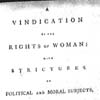 |
Mary Wollstonecraft. A Vindication of the Rights of Woman (1792). This work, represented in the collections of Carrie Chapman Catt, as well as Susan B. Anthony, was considered one of the first books written by a woman promoting women's rights to equality. (Susan B. Anthony Collection) |
Wollstonecraft's presence is also felt in the Carrie Chapman Catt Collection, which was the working reference collection of the National American Woman Suffrage Association. Six books by Wollstonecraft, including A Vindication, are included along with over 900 books, journals, and scrapbooks from the libraries of Anthony, Alice Stone Blackwell, Elizabeth Cady Stanton, and other early leaders of the women's suffrage movement. Both the Catt and Anthony collections can be used to trace the efforts of national, state, and local women's organizations to correct discrimination against women under the civil code and to secure their right to vote, through legislative action and, after 1878, by federal amendment to the Constitution--a campaign that would take forty-two years to win. In addition to the reports and proceedings of organizations, both collections contain personal accounts and scrapbooks compiled by participants at all levels.
Leaders of the Progressive movement urged social reform through democratic means. Other social movements of the twentieth century advocated different ways to change society. Materials documenting American extremist movements across the political spectrum form our largest twentieth-century historical collections. Most of the holdings relating to extremism came to the Library during the last twenty-five years. The first of these groupings arrived in the division in 1977 when we received several hundred pamphlets, broadsides, and posters through a combined purchase and exchange. The intended public of most of this collection, which ranges from the 1850s to the 1970s, was the Italian, German, and Russian urban immigrant communities in America. The Italian pamphlets, the largest single grouping, originated in cities like Lynn, Massachusetts; Patterson, New Jersey; Barre, Vermont; and Newark, New Jersey. Luigi Galleani, Petro Gori, Carlo Tresca, and Errico Malatesta are among the Italian anarchists represented. The extremist German formulation of anarchism can be studied in the pamphlets by writers like Johann Most, Max Nettlau, and Rudolf Rocker. Noteworthy is Most's Heimfeuerwerker [n.d.], described as "a guide to the scientific art of revolutionary warfare." The Detroit-based Federation of Russian Workers in the United States and Canada was active in propagandizing anarchism among Russian-language immigrant groups. Its publications program included authors at the extremes of the movement, both Prince Kropotkin, the philosophic father of anarchism, and the activist Alexander Berkman, who went to prison for his attempted assassination of the industrialist Henry Frick. The Spanish material primarily relates to anarchist activity during the Spanish Civil War. The pamphleteering activities of the Mexicans Guerro, Flores Magon, and Ocana Sanchez and the Catalan Joan Del Pie are well represented.
In 1986 the prominent historian of anarchism Paul Avrich donated to the Library his extensive collection of books, pamphlets, periodicals, manuscripts, and memorabilia relating to the movement. The collection is particularly rich in American and European publications issued after 1900, with a full range of important anarchist writers represented, such as Errico Malatesta, Mikhail Bakunin, Rudolf Rocker, Prince Kropotkin, Alexander Berkman, and Emma Goldman. The Goldman material is a notable example of how the Avrich Collection deepens the Library's resources in this area. Though the Library owns most of Emma Goldman's major works, the Avrich Collection contains ephemeral pamphlets such as Love among the Free and Trotsky Protests Too Much, Japanese and French translations of her autobiography, and later revisions of such important books as the 1911 and 1917 editions of Anarchism and Other Essays, as well as correspondence from Goldman to friends after her 1919 deportation from the United States.
In 1982 Congress transferred to the Library the pamphlet files of the House Un-American Activities Committee (HUAC), which consisted of some 4,000 items covering a wide range of topics: labor, communism, fascism, and neocolonialism were addressed by major figures in American communism and socialism. The publications in the collection are most extensive for the study of the American left. Complementing the huac materials is the Radical Pamphlet Collection, which is especially strong in materials on American communism, socialism, and anarchism from 1879 to 1980.
In 1981 the Library acquired from the firm M & S Rare Books approximately 10,000 pieces relating to American extremism. The M & S Collection contains a variety of American radical views, documenting the activities of extremist groups and their visions of the good community from 1925 to 1981, with the majority of the material from the years 1950 to 1981. The collection embraces a vast number of subjects in a wide range of formats and genres, including broadsides, pamphlets, books, newspapers, newsletters, magazines, subscription and membership cards, order blanks, petitions, catalogs, advertisements, article reprints, and bumper stickers. The collection is strongest in printed ephemera produced by many sorts of radical Americans. These materials chronicle the propagandizing, fund raising, theorizing, and other activities of radical groups. The greatest strength is in materials relating to the American radical right during the twentieth century. The holdings especially document the religious right's involvement with nationalism, anticommunism, antihumanism, anti-Semitism, and the movement for media decency. Various religious groups such as the Unification Church, Church of Scientology, and the Church of God International are described in part in some of the materials. To the extreme right within the religious movements represented are advocates of Identity theology, with its concurrent anti-Semitism and Holocaust revisionism, anticommunism, survivalism, and nationalism. Secular anticommunists and survivalists, neofascists, opponents of fluoridation of the water supply, and those distrustful of the United Nations are all among the groups chronicled.
Rare Book and Special Collections in American Memory
Library of Congress Home Page
 Library
of Congress
Library
of Congress